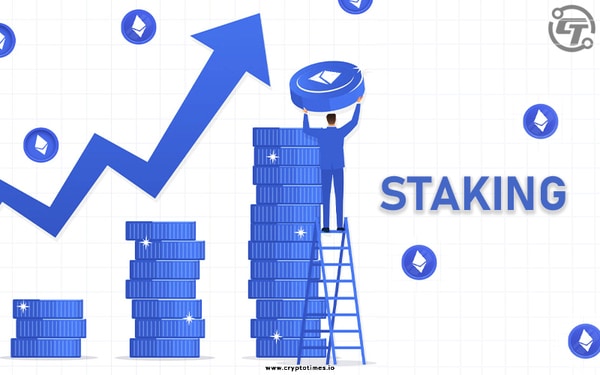Staking rates on the Ethereum blockchain have been on the rise since the implementation of the Shanghai upgrades in April 2023. The Shanghai upgrades made staking more accessible to institutional investors and increased the staking rewards, which has led to a significant increase in the number of ETH staked on the network.
This is good news for the Ethereum network, as staking makes it more secure, decentralized, and scalable. If you are interested in earning passive income by staking ETH, you must first buy some ETH. If you are confused about the buying process, click on the link to learn how to buy Ethereum. Now that you have ETH you can stake them directly on the Ethereum network, or you can use a cryptocurrency exchange or staking pool.
In this article, we delve into the significance of Ethereum’s accelerating staking rates, examining the driving factors behind this paradigm shift. If you wish to start earning passive income through staking, just keep on going.
Shanghai Upgrade
When Ethereum announced its Shanghai upgrade, there was concern that the feature allowing investors to withdraw their staked funds would lead to price instability due to expected mass withdrawals. However, after an initial dip in the week following the upgrade’s April 2023 launch, the trend has reversed, with investors continuing to add to their staked ETH.
The numbers have continued to climb despite the continued fluctuations and regulatory pressures, and currently, almost 20% of the entire coin supply is staked. A staggering 5% was recorded only during the past two months. The number of staked coins is over 23 million, the rough equivalent of $43.6 billion. But what are the reasons for this shift in user behavior?
The Shanghai upgrade also made staking more accessible to institutional investors. Prior to the upgrade, institutional investors had to stake ETH through a third-party service provider. However, the Shanghai upgrade made it possible for institutional investors to stake ETH directly on the Ethereum network.
According to a survey conducted by an institutional-grade staking services Klin, 68% of investors stated their intention to either commence staking or increase the amount they have staked after the Shanghai upgrade.
Here are some of the specific reasons why the Shanghai upgrade helped in increasing staking rate:
- It allowed users to withdraw their staked ETH. This was a major milestone for the Ethereum network, as it made staking more liquid and accessible to investors.
- It made staking more accessible to institutional investors. The Shanghai upgrade made it possible for institutional investors to stake ETH directly on the Ethereum network, rather than through a third-party service provider.
- It increased the staking rewards. The Shanghai upgrade also increased the staking rewards, making it more attractive for investors to stake their ETH.
Also Read: What’s Next After the Ethereum Merge?
Passive income
Right now there are more than 10 million ETH staked on the Ethereum network. This represents a significant increase from the number of ETH staked just a few years ago.
As more investors look for ways to generate income from their cryptocurrency holdings, they are turning to staking as a viable option. Staking allows investors to earn rewards by locking up their ETH and participating in the validation of transactions on the Ethereum network. This is a relatively low-risk way to generate passive income, as it does not require any involvement in the day-to-day operations of the network.
The increasing popularity of staking has made it easier for investors to participate. There are now a number of staking platforms that make it easy for investors to stake their ETH and earn rewards. These platforms typically offer a variety of features, such as staking pools, that make it easy for investors to participate in staking.
The rewards for staking ETH have been increasing. This is due to a number of factors, including the increasing demand for ETH and the growing popularity of staking. As a result, investors are earning more rewards for staking their ETH.
As the demand for passive income continues to grow, ETH staking is likely to become an even more popular option for investors. This is because staking offers a relatively low-risk way to generate income from cryptocurrency holdings. Additionally, the rewards for staking ETH are likely to continue to increase.
In addition to the reasons discussed above, there are a number of other factors that have contributed to the recent increase in staking rates. One factor is the increasing popularity of liquid staking, which allows users to stake their ETH without having to lock it up. Another factor is the increasing number of staking pools, which make it easier for users to stake smaller amounts of ETH and still earn rewards.
Now that we have covered some of the basics of staking, let’s take a look at how you can start staking your ETH.
How to Start ETH Staking
How Staking Works
Staking is the process of locking up ETH in order to participate in the validation of transactions on the Ethereum network. Validators who stake ETH are rewarded with ETH, which is paid out in block rewards and transaction fees. The amount of ETH that is rewarded to validators is based on the amount of ETH that they have staked.
Different Types of Staking
There are two main types of staking: liquid staking and delegated staking. Liquid staking allows users to stake their ETH without having to lock it up. This is done by using a third-party service that holds the user’s ETH and stakes it on their behalf. Delegated staking allows users to delegate their staking rights to another user, who will then stake the ETH on their behalf.
How to Stake Ethereum
There are a number of ways to stake your Ethereum. One way is to use a cryptocurrency exchange that offers staking services. Another way is to use an Ethereum staking pool. Staking pools are groups of users who pool their ETH together and stake it as a single entity. This allows users to stake smaller amounts of ETH and still earn rewards.
The Potential Impact of Staking on the Ethereum Network
The potential impact of staking on the Ethereum network is significant. Here are some of the benefits that staking could bring:
- Increased security: Staking will make the Ethereum network more secure by distributing the responsibility of validating transactions among a wider pool of participants. This will make it more difficult for malicious actors to attack the network.
- Decentralization: Staking will also help to decentralize the Ethereum network by making it possible for anyone to participate in validating transactions, regardless of their financial resources. This will make the network more resistant to censorship and manipulation.
- Scalability: Staking could also help to improve the scalability of the Ethereum network by reducing the energy consumption required to validate transactions. This could allow the network to handle more transactions per second, which would make it more attractive to developers and users.
Also Read: All About Ethereum Staking
Conclusion:
As staking continues to gain momentum, it offers investors a compelling opportunity to earn passive income while contributing to the overall strength and resilience of the Ethereum ecosystem.
Whether you are a seasoned investor or a newcomer to the world of cryptocurrency, exploring the possibilities of ETH staking could be a worthwhile venture in the ever-evolving landscape of decentralized finance.






